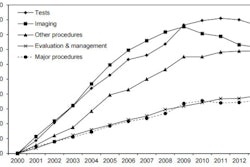
Recommendations for medical imaging are noticeably absent in the Medicare Payment Advisory Commission's (MedPAC) June report to Congress -- a welcome break from the usual scrutiny that radiology receives from policymakers.
Instead, the report focuses on ways to coordinate policy across three Medicare payment systems: traditional fee-for-service models, Medicare Advantage health plans, and accountable care organizations (ACOs), which are a variation of fee for service.
Last June, MedPAC suggested that no one model is the least costly in all markets, and to maximize the value of the Medicare program for its beneficiaries and for taxpayers, Medicare needs to set payment rules that reward the most efficient model of care in particular markets.
In the current report, MedPAC explores the topic using the following examples:
- A nationally set base premium that pays for fee-for-service Medicare in every market
- A nationally set base premium that pays for fee-for-service Medicare or the Medicare Advantage plan, whichever costs less in each market
- A locally set base premium that pays for fee-for-service Medicare or the Medicare Advantage plan, whichever costs less in each market
In any case, reforms to established payment models require long-term effort, MedPAC Executive Director Mark Miller, PhD, said in a press conference.
"Investigation of payment models started in the June 2014 report, and this report builds on that work," he said. "I wouldn't expect immediate recommendations to come out about this."
The current report also addresses how to measure quality. Last year, the commission suggested a quality measurement concept that would use a small set of population-based outcome measures that could be compared across the three payment models. In this report, MedPAC investigates what it calls "healthy days at home."
"The intent of a 'healthy days at home' measure is to capture the number of days within a set period that a beneficiary is alive and does not have interactions with the healthcare system that imply poor health," MedPAC wrote. "Our initial analysis of [the 'healthy days at home' measure] using Medicare claims data suggests that such a concept may be a meaningful and understandable way to compare differences in relative health status across populations."
Also new this year is the permanent sustainable growth rate (SGR) formula fix that passed Congress in April, Miller said. How might this event affect Congress' healthcare reform perspective?
"If you look at any piece of legislation that's gone through Congress in the last decade, it often includes recommendations from us," he said. "Congress has been paying close attention to what we do, and resolving the annual SGR patch could free them up to think more broadly about healthcare policy."




















